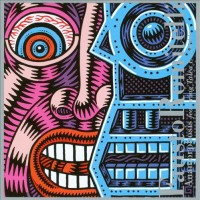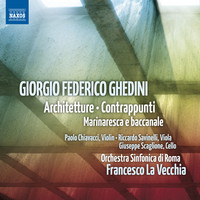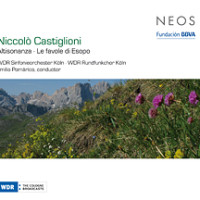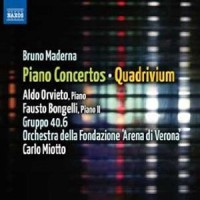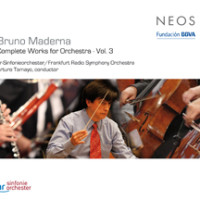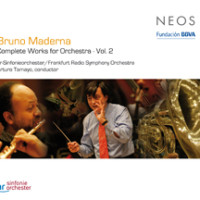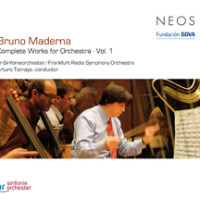Italian Vacation 9.
|
Grant Chu Covell [August 2013.]
“Anamorphosis.” Fausto ROMITELLI: Amok Koma (2000); Domeniche alla periferia dell’impero (1996, 2000); La sabbia del tempo (1991); Nell’alto dei giorni immobili (1990); Blood on the floor, Painting 1986 (2000). Talea Ensemble. Tzadik TZ 8087 (http://www.tzadik.com/). Just what is it about Romitelli? I’ve circled through this disc many times and have deepened my understanding of Romitelli’s music since enjoying a big dose back here. Perhaps obvious to others, I finally noticed that Romitelli avoids melody. He scatters broken chords across the furniture, sometimes casually, other times mischievously. The pulse is not clearly defined and the individuals’ appearances feel random as they coalesce to form chords and concurrent lines. Absent traditional melodies, gestures trend up or down and notes rarely repeat. If a gesture’s second pitch ascends, then so usually does the rest of the phrase, unless a trill or some embellishment was started. Similarly, the third note after two descending notes will probably continue downward. Romitelli also likes contrary motion. Rarely are gestures repeated within the fog. Harmony is created through high and low notes, rarely anything in the middle as if looking through a lens scratched at the center. There are fast passages and instruments can wander; on the whole Romitelli’s textures are predominantly dissonant broken arpeggios unevenly ringing changes. I wanted to hear a palindrome in Amok Koma. No such luck. Romitelli’s alternately delicate and brutal textures proved too distracting. If a magic reversal appears, I missed it. In the second of the two Sundays, dedicated to Grisey, I heard touches of the Sehr langsam – Misterioso movement of Mahler’s Third. The gloominess, the way the upper line imitates Mahler’s soprano and eventually breaks into a rocking two step followed by harmonics. La sabbia del tempo suggests that Romitelli’s outlook was gloomy. A modified Pierrot ensemble (flute, clarinet, violin, viola, cello, with sampler replacing piano) pauses at the center and continues after the most subtle Schubert Quintet quote. Mahler’s Misterioso appears towards the end here too. I hadn’t expected these references. The Talea Ensemble was born to play this music. Romitelli asks for blends and balances which are probably impossible for most groups, such as clarinet and violin which must fuse into a sound indistinguishable from the electronics which flow underneath.
Giorgio Federico GHEDINI: Concerto for Orchestra, “Architetture” (1939-40); Contrappunti (1960-61); Marinaresca e baccanale (1933). Paolo Chiavacci (vln), Riccardo Savinelli (vla), Giuseppe Scaglione (vlc), Orchestra Sinfonica Di Roma, Francesco La Vecchia (cond.). Naxos 8.573006 (http://www.naxos.com/). Naxos provides a top-shelf recording of the overlooked Ghedini (1892-1965) who taught many including Berio, Castiglioni and Donatoni. I have seen Ghedini’s editions of Vivaldi, and he transcribed pre-Baroque composers such as Monteverdi and the Gabrielis. Some of his band arrangements are still played. These three consistently indefinable orchestral pieces barely hint at Ghedini’s interest in older music. If playing the needle-drop game with Ghedini on the platter, my first guess would be Martinů, and after that, maybe Britten, Hindemith or some other composer I do not know well. Ghedini appears to have sidestepped both Stravinsky and Schoenberg’s influence. The distinctive results are not an occasion for jubilation. Ghedini can be dissonant, but neither atonal nor serial. Supporting ideas might be repeated near minimally. Fluent orchestration highlights ever-changing material in a cubist, perhaps Futurist fashion. Architetture, a Concerto for Orchestra, brought late recognition to the Piedmontese composer. In each of seven movements, instrumental families examine spare ideas. The first movement includes concertante piano and a brief bridging movement leading to the strings tussling with repeated scale fragments. “Counterpoints” calls for an unusual combination of string trio and orchestra. No precedent comes to mind. I feel sorry for the buried viola. The trio dips and surges out of the Brahmsian texture. Because of its murky angularity, Ghedini’s earliest work here, “Sea Piece and Bacchanale” sounds quite unlike any other sea portrait. A passing moment with foghorn pedals and splashing spray pokes at Wagnerian archetypes. The Bacchanale, an unbridled Presto, prefigures Adams’ pieces 40 years later, an Art Deco tarantella. Naxos stocks other less strange Ghedini. Massimo Giuseppe Bianchi works through the entire piano oeuvre. Vol. 1 (8.572329) includes miniature Canons from 1909-10 which rise above academic doodles although the full set of 29 is best enjoyed in doses. The Nine Pieces of 1913-14 demonstrate effective brushwork. Vol. 2 is on Naxos 8.57230.
Niccolò CASTIGLIONI: Altisonanza (1990-92); Le favole di Esopo (1979). WDR Sinfonieorchester Köln, WDR Rundfunkchor Köln, Emilio Pomàrico (cond.). Neos 11031 (1 SACD) (http://www.neos-music.com/). Because Castiglioni created precise and delicate textures, the prospect of orchestral music seems overwhelming and extroverted. Castiglioni explores the large forces’ instrumental potential, maintaining his characteristically capricious outlook. Altisonanza’s three movements, Entrée, Sarabanda, Perigordino portray the Dolomites where the Milanese native spent the last years of his life. The work charts vistas of mountains and valleys, for Castiglioni, all good and pure places. Animal sounds are perhaps provided by high winds, piano or brass. The Sarabanda filters Webern through late Stravinsky and closes gently upon a hushed major chord. While the free-form patchwork suggests that Castiglioni was an amateur, it takes an effort to invent naive folksongs. I hear a beloved landscape portrayed as a cubist progression. “Aesop’s Fables” adds chorus to orchestra. There are moments that could be atonal Schoenberg (Prologue) or Messiaen when the piano imitates birdsong (Sinfonia I). But just when the genre seems settled, Castiglioni will appropriate Brahms. A prologue and epilogue bookend six Sinfonias that alternate with five fables.
Bruno MADERNA: Piano Concerto (1942)1; Piano Concerto (1942; arr. for two pianos, 1946)2; Concerto for two pianos and instruments (1948)3; Quadrivium (1960)4. Aldo Orvieto1,2,3, Fausto Bongelli2,3 (pno), Gruppo 40.63, Orchestra della Fondazione ‘Arena di Verona’ 1,4, Carlo Miotto1,3,4 (cond.). Naxos 8.572624 (1 CD) (http://www.naxos.com/). “Bruno Maderna: Works for Orchestra. Vol. 1.” Bruno MADERNA: Composizione n. 1 (1948-49); Composizione n. 2 (1950); Studi per “Il processo” di Franz Kafka (1950); Improvvisazione n. 1 (1952); Improvvisazione n. 2 (1953). Michael Quast (speaker), Claudia Barainsky (sop), hr-Sinfonieorchester / Frankfurt Radio Symphony Orchestra, Arturo Tamayo (cond.). Neos 10933 (1 SACD) (http://www.neos-music.com/). “Bruno Maderna: Works for Orchestra. Vol. 2.” Bruno MADERNA: Composizione in tre tempi (1954); Concerto per flauto e orchestre (1954)1; Aria (1964)2; Dimensioni III (1962-63)3; Stele per Diotima (1966)4. Thaddeus Watson1 (fl), Claudia Barainsky2 (sop), Sebastian Wittiber2 (fl), Clara Andrada de la Calle3 (fl, picc), Alejandro Rutkauskas4 (vln), Jochen Tschabrun4 (clar), Ulrich Büsing4 (b-clar), John MacDonald4 (hn). hr-Sinfonieorchester / Frankfurt Radio Symphony Orchestra, Arturo Tamayo (cond.). Neos 10934 (1 SACD) (http://www.neos-music.com/). “Bruno Maderna: Works for Orchestra. Vol. 3.” Bruno MADERNA: Ausstrahlung (1971)1; Biogramma (1972); Grande Aulodia (1970)2. Carole Sidney Louis1 (sop), Thaddeus Watson1,2 (fl), Michael Sieg1,2 (ob), hr-Sinfonieorchester / Frankfurt Radio Symphony Orchestra, Arturo Tamayo (cond.). Neos 10935 (1 SACD) (http://www.neos-music.com/). A versatile conductor and affable colleague, Maderna influenced many mid-20th century composers. His own music appears to have had less sway. A Naxos release combined with an ongoing Neos series affords an opportunity to take stock of Maderna’s evolution amid 20th-century trends. At first Maderna absorbed Bartók precociously, but then like everyone else, he fell under serialism’s spell only to drift towards chance and polystylism. Several themes persist across Maderna’s work irrespective of style. He had an abiding love for lyric melody as the many concertante situations for oboe and flute attest. He also appears to have had a recurring need to reject authority: Unexpected gestures may conclude stringent formalism and precision work. Perhaps his wide-ranging conducting repertoire predisposed him towards polystylism. Fabio Zannoni’s gushing program notes for Naxos proclaim Maderna’s genius as self-evident. Passing quickly in under 12 minutes, the 1942 three-part Piano Concerto displays a proficient grasp of late-Romanticism’s twilight. Curiously, the identical moody content arranged for two pianos charts a completely different course. The two-piano concerto explicitly asserts its debt to Bartók. The program’s big attraction, a mature Maderna exemplar, jumps a lifetime away. Combining randomness and serial organization, the 31:41 Quadrivium (1960) requires four orchestral groups plus ample percussion. Just a few years after these early concertos, the generically titled Composiziones (1948-49 and 1950) link contrasting episodes and summarily reject the past with strident serialism. Neos’ notes dare suggest that with its four-part structure Composizione n. 1 (20:42) might have been a symphony. Composizione No. 2 (14:51) gets right to business with flowing wind solos which augur the later concertos, but its various episodes include waltzes and a rumba. Did this raise eyebrows at the time? The Trial (1950) lends itself to angry serial pages, including electric guitar. Here’s something to pair with Schoenberg’s 1947 Survivor. Improvvisazione n. 1 (1952), starts from lightness, then lurches into mutated dance forms: a waltz, polka, and then Can-Can, all in less than 11 minutes. The seven-minute Improvvisazione n. 2 (1953) also looks for variety. It’s unclear just how these might be improvisations. Perhaps they reflect their compositional situations. The diminutive (8:04) and brash Flute Concerto (1954) with much flutter-tonguing and struck percussion seems to be one of Maderna’s few fast-paced concertos. In later years, lyricism yielded to slowness: Dimensioni III (1962-63) opens robustly, but eventually strands its flute / piccolo soloist, and Grande Aulodia (1970), a double concerto for solo flute and oboe, slinks into lethargy. I find the non-concerto, purely orchestral works most satisfying. Composizione in tre tempi (1954) provides spiky serial lines that bounce between instruments. Percussion and mandolin provide bright colors. The first movement dissipates into neoclassicism as the music encounters traditional Venetian melodies, further evidence of Maderna’s unwillingness to commit to a single genre within a work. Stele per Diotima (1966) has solo moments for violin, clarinet, bass clarinet and horn. The orchestra is used sparingly, presenting abrupt chords like broken pillars. Percussion provides the greatest variety in this nearly 20-minute work. Biogramma (1972) doesn’t dawdle in its terse 12 minutes. Centering on the flute, Neos’ Vol. 2 includes three pieces which in various guises had found their way into the 1964 open-form opera Hyperion: Aria, Dimensioni III and Stele per Diotima. With texts by Hölderlin, Aria (1964) adds soprano to solo flute and orchestra, and like the Kafka setting seems conservative compared to its neighbors. At 33-minutes-plus, Ausstralung (1971) adds solo soprano, flute and oboe to tape and orchestra. Seven “Emanations” are to be sequenced at the conductor’s pleasure. The soprano and tape’s texts are taken from Persian literary and historic sources. It’s leisurely, abstract and a bit jazzy. The children’s voices repeating “so wunderbar” (Maderna’s daughters immortalized on tape) unnerve. Neos’ Vol. 4 (Neos 10936) offers Quadrivium, Aura, Amanda and Giardino religioso; Vol. 5 (Neos 10937) presents the 1959 Violin Concerto and the mature Piano Concerto from 1959. Presumably the series will grow to include the three oboe concertos and perhaps the opera Satyricon. It’s an ambitious, necessary project even though its inherent variety won’t satisfy everyone. The Frankfurt Radio Symphony Orchestra plays these pieces fluently, as if they were a daily staple. Tamayo is an excellent tour guide as his Xenakis series on Timpani proves.
[More Grant Chu Covell, Italian Vacation]
[Previous Article:
IPC’s Acoustic Equalizer Panels]
[Next Article:
Schoeck’s Notturno, a survey]
|
